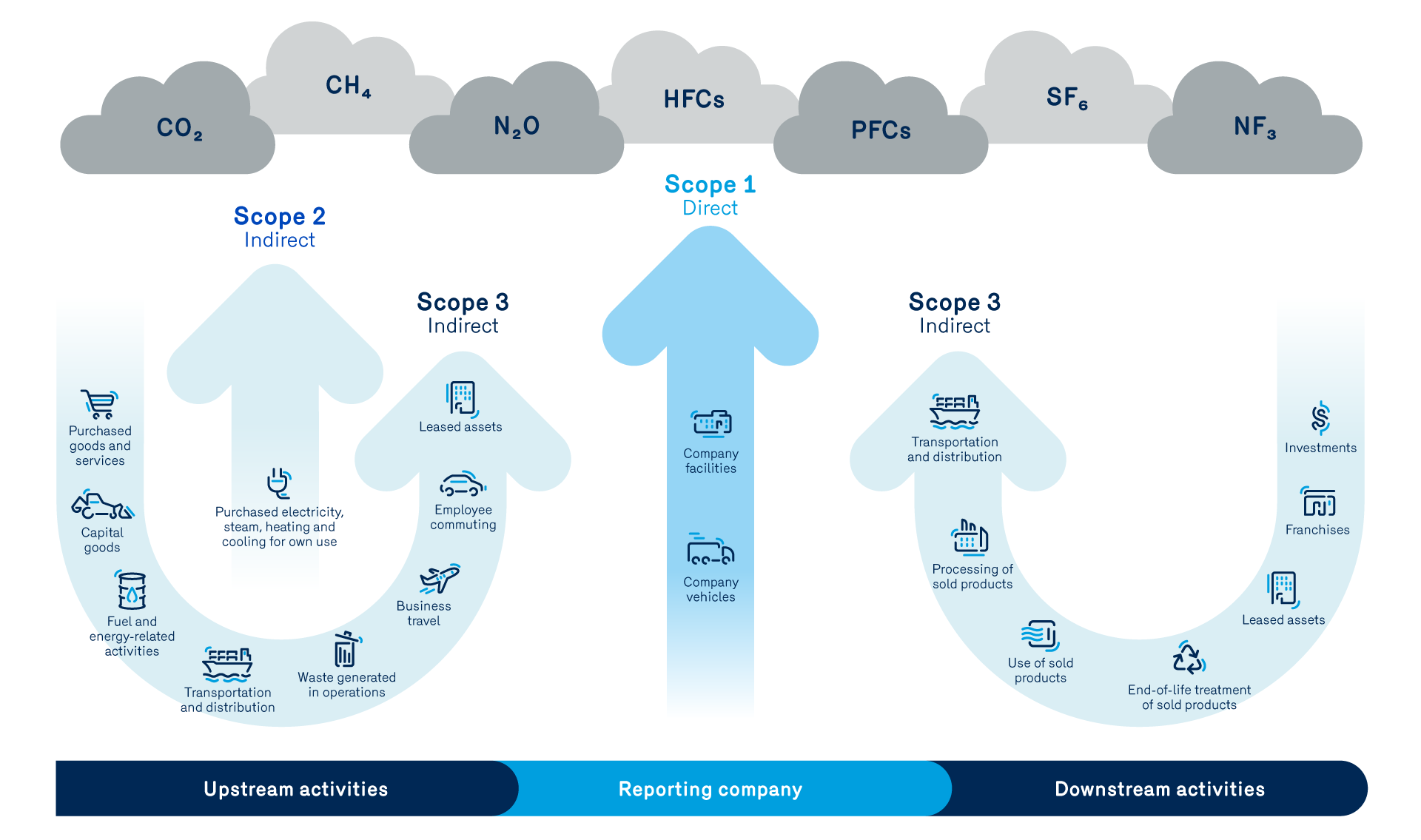Énergir offers energy solutions designed to reduce the use of fossil natural gas or replace it with a renewable energy source, renewable natural gas (RNG). These offers help reduce fossil greenhouse gas (GHG) emissions, thereby contributing to the fight against climate change.
Energir provides this reference page detailing the methodologies used to quantify the GHG emission reductions associated with its decarbonation offers.
This page presents the methodologies that support the data advanced throughout the Energir website. It is an essential resource for understanding how the GHG emissions associated with the use of natural gas and RNG are calculated, as well as the reductions achieved through the various decarbonization offers.
In particular, you will find:
- The methodology generally used by Énergir to assess environmental impacts
- Calculations of the GHG emissions associated with the combustion of fossil natural gas and RNG
- The methods for calculating emissions reductions from the proposed decarbonization offers
Quebec’s Regulation respecting mandatory reporting of certain emissions of contaminants into the atmosphere (RMRCECA) requires any person operating a facility in Quebec (and carrying out one of the activities covered by the regulation) that emits 10,000 tonnes or more of carbon dioxide equivalent (“CO₂e”) in a calendar year to report their emissions to the Quebec Minister responsible for the environment, in accordance with the RMRCECA.
The RMRCECA includes several calculation protocols, each named according to the activity performed. Each protocol contains calculation methodologies and emission factors to be used, particularly based on the type of process or equipment involved. For the combustion of natural gas and RNG (renewable natural gas), the RMRCECA provides combustion-phase emission factors for various uses in Protocol QC1, titled “Combustion Using Stationary Equipment.” For the vast majority of facilities subject to the RMRCECA the emissions to be reported are direct (Scope 1) emissions.
Énergir is subject to the RMRCECA both for emissions related to the operation of its natural gas network (Scope 1) and for emissions associated with the use of natural gas by most of its customers1 (which represents a significant portion of Énergir’s Scope 3 emissions).
In this context, Énergir generally relies on Protocol QC.30, “Fuel and Combustible Distribution,” which applies to fuel and combustible distributors (such as Énergir) under the RMRCECA, to quantify emissions related to the combustion of fossil natural gas and RNG.
This page provides a way to quantify the emissions and emission reductions associated with Énergir’s offerings, based on the methods and factors from the RMRCECA. However, these are distinct from the methodologies Énergir uses to comply with its mandatory reporting obligations under the RMRCECA. The RMRCECA’s approach should also be distinguished from other regulatory frameworks, such as Canada’s Clean Fuel Regulations, which adopt a life-cycle approach for fuels used in Canada.
Regardless of their reporting obligations under applicable regulations, many organizations voluntarily quantify their GHG emissions following recognized protocols. In this type of GHG emissions report, emissions are presented in three broad categories known as “scopes,” “emissions categories” or “reporting categories” (see Corporate Standard | GHG Protocol or ISO 14064-1 for more information). This categorization of emissions distinguishes them according to the organization’s level of control over them.
| Emissions categories | Examples |
| Direct emissions (Scope 1) are those from sources owned or controlled by the organization quantifying its emissions. These sources may be stationary or mobile. |
|
| Indirect emissions from purchased energy (Scope 2), i.e. from fuel combustion associated with the production of final energy purchased and used by the organization. By definition, this category is not directly under the control of the organization quantifying its emissions. |
|
| Indirect emissions (Scope 3) come from many emission sources upstream and downstream along the value chain. By definition, an organization that produces a GHG report has little or no control over these emission sources. The GHG Protocol identifies 15 subcategories. The organization must select the emission sources that are relevant and meaningful for its context. |
|

Source : diagram reproduced from the “Diagram of scopes and emissions across the value chain” in the Greenhouse Gas Protocol's “Corporate Value Chain (Scope 3) Accounting and Reporting Standard”, available on the Corporate Standard | GHG Protocol website.
Life cycle carbon intensity, often referred to as carbon intensity, is another approach to quantifying a product’s emissions using a life cycle analysis (LCA) methodology. Carbon intensity is generally expressed as CO2 equivalent per unit of the assessed product (e.g. grams of CO2 equivalent per MJ for energy). An LCA covering the entire life cycle, from raw material extraction to end of product life, is a “cradle-to-grave” LCA. A partial or “cradle-to-door” LCA ends when finished products leave the manufacturer’s facility. Under certain conditions, a product’s carbon intensity can be used to quantify an organization’s Scope 3 emissions, but this isn’t always possible and depends in particular on the scope of the calculated intensity factor.
For fuels including fossil natural gas, combustion emissions are the largest and account for approximately 82% of life-cycle GHG emissions, according to a 2020 study conducted by CIRAIG at Énergir’s request.
Would you like to learn more about the LCA of natural gas in Quebec?
Read the fact sheet or the full CIRAIG report
GHG emissions are calculated taking into account the combustion phase, consistent with the method and emission factors set out in the RMRCECA for natural gas or biomethane (RNG) for the residential, commercial, institutional, agricultural and construction sectors.
The version of the Regulation respecting mandatory reporting of certain emissions of contaminants into the atmosphere (RMRCECA) referred to on this page is the one in force from December 1, 2024. See the https://www.legisquebec.gouv.q....
RMRCECA emission factors for natural gas or biomethane (RNG)
| Emission | Factors | Units | Information source |
| CO2 | 1.878 | kg of CO2/m3 | RMRCECA Table 1-4 |
| CH4* | 0.037 | g of CH4/m3 | RMRCECA Table 1-7 |
| N2O* | 0.035 | g N2O/m3 | RMRCECA Table 1-7 |
*The CH4 and N2O factors correspond to the factor for the residential, commercial, institutional, agricultural and construction sectors.
These factors correspond to a temperature of 20 °C and a pressure of 101.325 kPa. Consequently, the adjustment of volumes corresponds to the application of a multiplication factor of 1.017352, obtained according to the law of perfect gases to correct the reference temperature from 15°C to 20°C, i.e. :
Volume at 20°C = Volume at 15°C × 1.017352
The RMRCECA uses the Global Warming Potentials (GWP) of the IPCC 4th Assessment Report to quantify GHG emissions. The global emission factor used for fossil natural gas is 1.889 kg CO2 eq/m3.
Simplified formula for calculating GHG emissions from fossil natural gas:
Natural gas volume adjusted to 20 °C | × | Overall emission factor | = | Quantity of GHG emissions |
It should be noted that the RMRCECA also provides for other ways of calculating emissions, notably by integrating the gross calorific value when this information is available. This is the method used by Energir in its annual declarations under the RMRCECA. When quantifying emissions and emission reductions to compare alternatives, as is the objective of this page, the use of volume-based factors expressed in CO2e/kg or CO2/kg assumes a default gross calorific value of 38.32 GJ/103 m3 as indicated in the RMRCECA.
To calculate GHG emissions from RNG, the RMRCECA uses the same emission factors as for fossil natural gas (see the table below). According to the RMRCECA, RNG combustion therefore emits as much CO2, CH4 and N2O as fossil natural gas combustion. However, in the case of RNG, these CO2, CH4 and N2O emissions are biogenic, meaning they originate from biomass.
Therefore, the volumes reported by Énergir, which are based on a temperature of 15 °C, must be adjusted to a temperature of 20 °C by applying the ideal gas law. The adjustment is obtained by multiplying Énergir’s volumes by 1.017352 (see previous section for details on emission factors).
According to the GHG quantification and reporting methods recognized under ISO 4064-1 or the GHG Protocol, CO2 emissions from biomethane must be quantified and reported separately from other emissions, as they come from biogenic sources.
- Biogenic CH4 and N2O emissions must be quantified along with non-biogenic emissions: they are equivalent to an overall factor of 0.011 kg CO2 eq/m3.
- The portion of CO2 of biogenic origin must be quantified but reported separately in accordance with ISO 14064-1 and the GHG Protocol. Biogenic CO2 is equivalent to an overall factor of 1.878 kg eq. CO2/m3.
RMRCECA emission factors for natural gas and RNG
| Emissions | Factors | Units | Information source | Treatment of these emissions |
| CO2 | 1,878 | kg of CO2/m3 | RMRCECA Table 1-4 | Quantified and reported out of scope. Do not need to be covered under CATS. |
| CH4* | 0,037 | g of CH4/m3 | RMRCECA Table 1-7 | Quantified and reported as Scope 1, 2 or 3 emissions, as applicable. |
| N2O* | 0,035 | g N2O/m3 | RMRCECA Table 1-7 | Quantified and reported as Scope 1, 2 or 3 emissions, as applicable. |
*The CH4 and N2O factors correspond to the factor for the residential, commercial, institutional, agricultural and construction sectors
Simplified formula for calculating CH4 and N2O GHG emissions from RNG:
| Natural gas volume adjusted to 20 °C expressed in m3 | X | Overall emission factor expressed in kg CO2e/m3 | = | Quantity of GHG emissions |
Simplified formula for calculating biogenic CO2 emissions from RNG:
| Adjusted natural gas volume at 20 °C expressed in m3 | X | Overall emission factor | = | Quantity of GHG emissions expressed in kg CO2 |
What are biogenic emissions?
“Biogenic” refers to what is produced by living organisms and therefore to the short carbon cycle (as opposed to the long cycle, which generated fossil fuels).
In the short carbon cycle, atmospheric CO2 is rapidly recycled. It is the substrate that plants transform into biomass during photosynthesis. When this biomass is burned or decomposes, it emits so-called biogenic CO2, CH4 and N2O.
According to the GHG quantification conventions (ISO 14 064-1 and the GHG Protocol), biogenic CO2 must be reported separately from other emissions. Its real climate effect depends on a variety of factors, including the source of organic waste. In contrast, fossil natural gas combustion releases CO2 that has been sequestered for millions of years in geological formations. While it may be sequestered again through photosynthesis, burning fossil fuels results in a net addition of GHGs to the atmosphere.
Unlike CO2, CH4 and N2O from biomass cannot be converted back to biomass during photosynthesis. The IPCC therefore considers that biogenic CH4 and N2O contribute to climate change. Biogenic CH4 and N2O must therefore be reported along with the other emissions in the appropriate scopes (not separately, like biogenic CO2).
Mandatory reporting of GHG emissions and coverage of RNG emissions
Under the RMRCECA, biogenic CO2 emissions must be reported but do not have to be verified or covered under the SPEDE regulation, while biogenic CH4 and N2O emissions must be verified and covered under the SPEDE regulation.
Énergir offers its customers three main decarbonization packages: energy efficiency, dual-energy, and the purchase of RNG. To assess the GHG reductions associated with these decarbonization offers, Énergir calculates the emissions avoided by implementing a decarbonization offer compared to a baseline scenario.
General approach to calculating the GHG emission reductions for the solutions:
Quantified emissions for baseline scenario | - | Quantified emissions for the scenario incorporating one or more Énergir decarbonization offers | = | Emissions reductions |
Generally speaking, Energir estimates that dual energy can shift around 70% of natural gas consumption to electricity, thereby reducing the GHG emissions associated with natural gas combustion. This proportion varies considerably according to various parameters, including winter temperatures and the temperature at which natural gas is switched to electricity. It can also vary, but to a lesser degree, depending on the appliances installed (e.g., a standard heat pump, an efficient heat pump, an electric boiler) and other parameters. The switchover temperature varies from region to region (the natural gas system takes over at -12°C and below, or at -15°C and above). The figure of 70% of displaced natural gas consumption is therefore an estimate and does not correspond exactly to the situation of any particular customer.
Calculation of emission reductions associated with Energir's dual-energy grant program rules
The methodology for calculating emission reductions associated with Energir's dual-energy grant program rules involves applying an estimated share of volumes converted to bi-energy to the initial annual volume of natural gas consumption, depending on the type of building and the efficiency of its equipment. GHG reduction percentages vary according to building type and the presence or absence of efficient equipment.
Reduction percentages applied
Here are the values applied:
Building type | Estimated GHG reduction |
Residential (single-family, condo, townhouse) | 70 % |
Multi-dwelling (duplex and triplex) | 70 % |
Multi-dwelling (4 to 19 units) | 70 % |
Commercial, institutional, industrial without efficient equipment | 65 % |
Commercial, institutional, industrial with efficient equipment | 56 % |
Emissions calculation for Énergir’s reporting and environmental disclosures
In its reporting to the Régie de l’énergie and disclosure of its climate performance, Énergir calculates the GHG emissions reductions associated with dual-energy systems based on the actual natural gas consumption of customers enrolled in the dual-energy program. It compares the results to the emissions from the combustion of a reference volume of natural gas for these customers. This reference volume is determined as follows:
- For a gas supply contract signed three or more years ago, the average annual volume consumed is calculated based on the last 36 months.
- If the contract is more recent, the volume consumed over the last 12 months is used.
- These volumes are measured at a temperature of 15 °C and a pressure of 101.325k Pa.
The emissions are then calculated using the method described in the section Calculating GHG emissions from fossil natural gas.
In its reporting to the Régie de l’énergie and disclosure of its climate performance, Énergir calculates the GHG emissions reductions associated with energy efficiency measures based on the actual natural gas consumption of customers who have implemented energy efficiency projects.
It compares the results to the emissions from the combustion of reference volumes of natural gas before they implemented their projects. The reference volumes are determined as follows:
- For a gas supply contract signed three or more years ago, the average annual volume consumed is calculated based on the last 36 months.
- If the contract is more recent, the volume consumed over the last 12 months is used.
- These volumes are measured at a temperature of 15 °C and a pressure of 101.325k Pa.
The emissions are then calculated using the method described in the section Calculating GHG emissions from fossil natural gas.
Énergir calculates the GHG emissions reductions associated with RNG consumption using the methodologies described in the sections of Part 2, distinguishing between:
- The baseline scenario emissions (100% fossil natural gas in its network) and
- The emissions from the situation corresponding to its regulatory obligation to deliver a proportion of RNG as provided for in the Regulation respecting the quantity of gas from renewable sources to be delivered by a distributor. The proportion for Énergir’s 2024–2025 fiscal year is 2%, which will increase to 5% in 2025–2026.
For customers, emissions reductions are calculated based on the proportion of RNG purchased by the customer.
The emissions are then calculated using the method described in the section Calculating GHG emissions from fossil natural gas.
About the carbon intensity of RNG and other fuels
With the help of external experts, Énergir is working to quantify the carbon intensity of the RNG it purchases. The carbon intensity for its RNG supply as a whole is not yet available. In its Greenhouse Gas Emissions Quantification Guide, the MELCCFP presents carbon intensity factors (cradle-to-grave and cradle-to-door) for different fuels using data from Environment and Climate Change Canada.
In quantifying GHG emission reductions that combine multiple offers, Énergir makes sure not to count any reductions twice. The reductions associated with the purchase of RNG in place of fossil natural gas apply only to residual volumes, after the other measures have been applied.
1. With the exception of its customers, who are themselves subject to the Quebec SPEDE.

